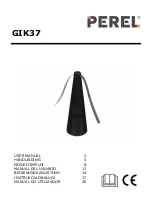
142
Propane System
Propane System Hoses,
Tubes, Pipes & Fittings
The hoses, pipes, tubes and fittings used in your propane system
are designed to withstand pressures exceeding those of the pro-
pane system. However, because environment and time can both
contribute to the deterioration of these components, they must
be inspected for wear at regular intervals. Be sure to inspect
the hose before each season and when having the tank refilled.
Look for signs of deterioration such as cracks or loss of flexibility.
When replacing the hose or other propane components, always
replace them with components of the same type and rating
(check with your dealer).
Fittings are used to connect the various system components to
each other. The P.O.L. fitting at the end of the propane supply
hose is made of brass so that pipe sealants are not necessary to
prevent leaking. It also has a left-handed thread, which means
that it is turned clockwise to remove, and counter-clockwise
to tighten. The P.O.L. fitting has been designed to help restrict
the flow of LP gas in the event of a regulator failure or hose
malfunction
Cooking with Propane
Unlike homes, the amount of oxygen supply is limited due to
the size of the RV. Proper ventilation when using the cooking
appliance(s) will help you avoid the danger of asphyxiation.
For additional safety instructions
,
See
pages 145-147
, Appliances.
Traveling with Propane
BEFORE towing your RV, ALWAYS check that the propane con-
tainers are properly fastened in place. Turn OFF the gas at the
LP bottle. This disables all gas appliances and pilot lights.
DO NOT operate the propane system when the RV is in motion.
Some states prohibit propane appliances to be operated during
travel (especially in underground tunnels). Make sure to know
the laws for the areas where you travel.
When there are
double cylinders
on your RV, use
only one at a time.
Otherwise, the propane
supply will be drawn equally
from both cylinders until the
supply has been exhausted.
Using one cylinder until
it is empty, before using
the second, allows you to
fill the empty cylinder at
your convenience without
running out of propane.
Summary of Contents for Momentum
Page 1: ...OWNER S MANUAL ...
Page 2: ......
Page 4: ...This page is intentionally blank ...
Page 6: ...This page is intentionally blank ...
Page 31: ...29 This page is intentionally blank ...
Page 36: ...34 This page is intentionally blank ...
Page 86: ...84 This page is intentionally blank ...
Page 87: ...85 This page is intentionally blank ...
Page 90: ...88 This page is intentionally blank ...
Page 106: ...104 This page is intentionally blank ...
Page 122: ...120 This page is intentionally blank ...
Page 123: ...121 Nautilus P1 Manual Nautilus P1 Manual ...
Page 124: ...122 Nautilus P1 Manual ...
Page 125: ...123 Nautilus P1 Manual ...
Page 126: ...124 Nautilus P1 Manual ...
Page 127: ...125 Nautilus P1 Manual ...
Page 128: ...126 Nautilus P1 Manual ...
Page 129: ...127 Nautilus P1 Manual ...
Page 130: ...128 Nautilus P1 Manual ...
Page 131: ...129 Nautilus P1 Manual ...
Page 132: ...130 Nautilus P1 Manual ...
Page 133: ...131 Nautilus P1 Manual ...
Page 134: ...132 Nautilus P1 Manual ...
Page 135: ...133 Nautilus P1 Manual ...
Page 136: ...134 Nautilus P1 Manual ...
Page 137: ...135 Nautilus P1 Manual ...
Page 138: ...136 This page is intentionally blank ...
Page 216: ...214 Customer Notes ...
Page 217: ...215 Customer Notes ...
Page 218: ...216 Maintenance Record Maintenance Record Date Work Performed Next Service ...
Page 219: ......















































